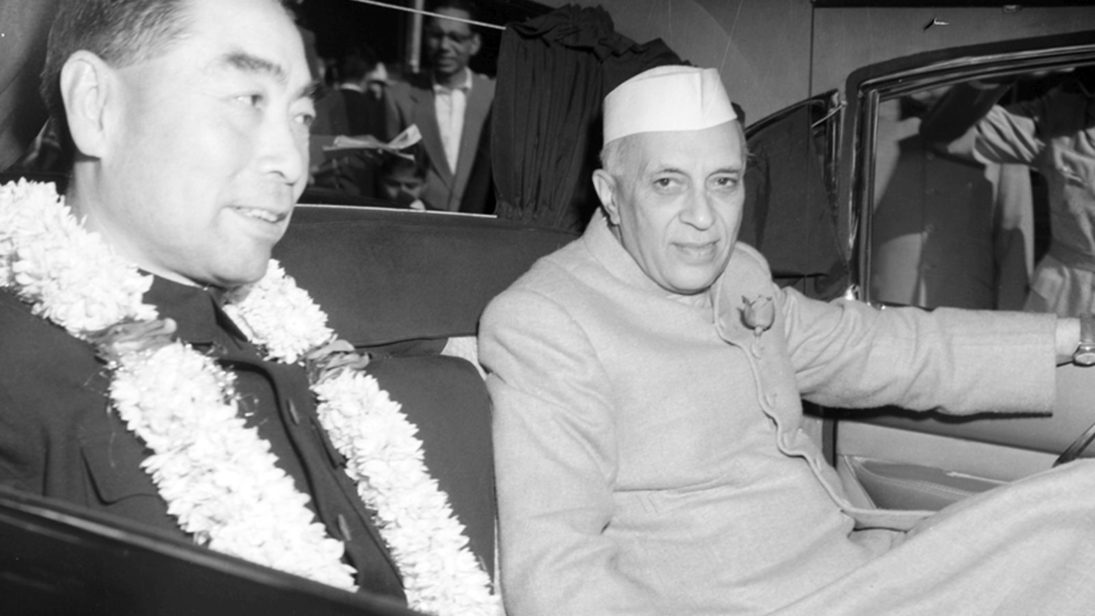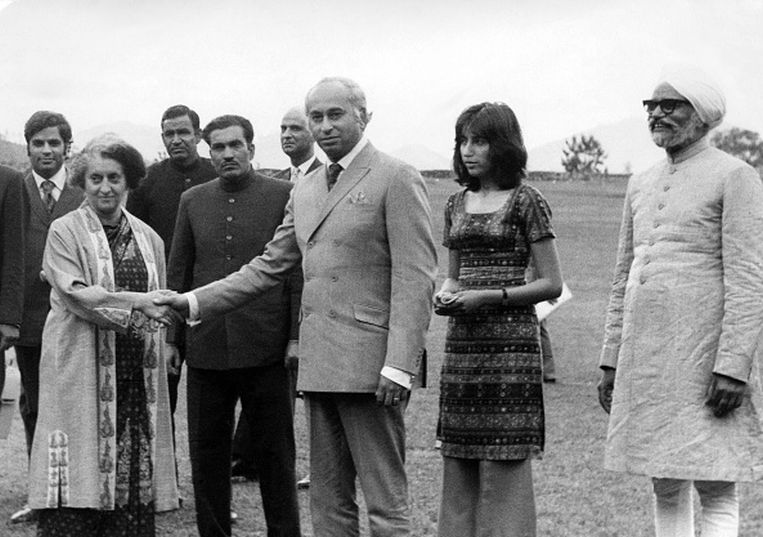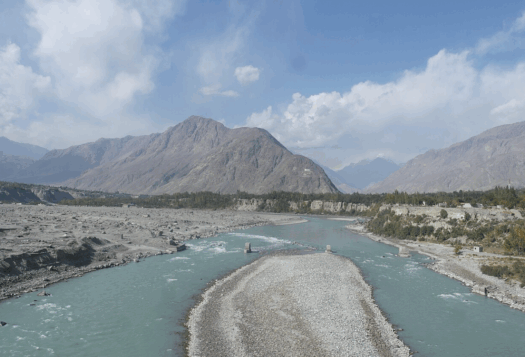
Even as India and China find themselves embroiled in yet another border standoff at the Line of Actual Control (LAC), commentators have sounded alarm on how Pakistan could seek to utilize the situation. Concurrently, some have observed that China’s transgression at the border is likely to push New Delhi closer to Washington, at a time when Sino-U.S. tensions are running high. A dyadic understanding of the security environment in Southern Asia, either through an India-Pakistan or India-China lens, is thus incomplete and does not account for the triangular dynamics that shape these interactions. To understand regional dynamics, it is critical to understand the India-Pakistan-China triangle and how it is impacted by the strategic chain, including the United States. The contemporary reality of these dynamics is grounded in an early Cold War history, and potential conflict scenarios involving these countries animate the geopolitics of Southern Asia.
A Triangle Made in History
The India-Pakistan-China triangle is mired in a convoluted history of unresolved border disputes, with military confrontations between India and China at the Line of Actual Control (LAC), and India and Pakistan at the Line of Control (LoC) occurring intermittently. In 1947, Britain’s hasty withdrawal from the subcontinent as a result of post-war decolonization led to a haphazard redrawing of political boundaries in Southern Asia, leaving some territory contested. The four wars that India and Pakistan have fought since 1947, the Sino-Indian Border War of 1962, and recurrent India-China and India-Pakistan conflicts at the LAC and LoC trace their genesis back to this protracted history. The military dimension of this triangle evolved in the years after the 1962 Sino-Indian Border War, when Beijing and Islamabad signed the border delimitation agreement in 1963. As part of this agreement, Pakistan handed over the Trans-Karakoram tract, a territory in Kashmir that India claimed, to China, turning the dispute into a trilateral one.
Further, during the 1965 India-Pakistan War, Pakistan felt betrayed by a lack of U.S. support, and chose to strengthen relations with China. Pakistan had expected the United States to tilt to its side, due to the 1954 U.S.-Pakistan mutual defense agreement and Pakistan’s membership in U.S. engineered alliances like the Southeast Asia Treaty Organization and the Central Treaty Organization. However, during and after the 1962 war, the United States showed hitherto unseen willingness to aid and assist India’s military against Communist China, making it prudent for China and Pakistan to join hands. Although Washington premised arming both Pakistan and India to achieve its Cold War objective to contain communism in Asia, neither side bought Washington’s assurances that its military supplies were not meant to be used against each other. Although China did not provide any direct military help to its new friend Pakistan during the 1965 war, it did engage in a psychological assault against India, repeatedly accusing New Delhi of showing aggression on the India-China border, and threatening Chinese reprisal.
During and after the 1971 India-Pakistan War, the United States tilted towards Pakistan, because it needed Islamabad as a conduit to Beijing during the 1972 Sino-U.S. rapprochement talks. Beginning in 1979, Pakistan played a frontline role for the United States in Afghanistan, in the last Cold War tussle between the United States and Soviet Union. In this context, geopolitics trumped nonproliferation concerns as Washington ignored intelligence that China was helping Pakistan develop a nuclear bomb. These conditions were hardly conducive for a healthy Indo-U.S. relationship, despite efforts at finding convergent points during the Reagan presidency. After the Cold War, the subsequent rise of China as a global power, followed by that of India, shifted dynamics of the India-China dyad, leading to heightened Sino-Indian competition, and tightening Sino-Pakistan military ties. Meanwhile, the India-Pakistan relationship remained volatile, taking an even more sinister turn as cross-border terrorism emanating in Pakistan targeted India, becoming a lingering roadblock to normalizing ties.
The Triangle in Contemporary Times
What characterizes this triangle is the geographical proximity of the three nuclear-armed countries, wherein any military standoff or confrontation is perceived as having the risk of use of nuclear weapons, or the probability of a two-front war for India, against a Sino-Pakistani combined military assault.
Today, both capabilities and intentions play a significant role in shaping perceptions and misperceptions within the India-Pakistan-China triangle. Specifically, Pakistan’s power asymmetry relative to that of India, and India’s power gap vis-à-vis China drive each state’s regional posture. Pakistan’s bid to enhance its capabilities, especially through nuclear deterrence and with Chinese assistance, is a means to counter India’s conventional superiority. Meanwhile, China’s growing military capabilities and defense modernization as well as its increasing role as a development and security partner for not only Pakistan but also a host of other states in India’s neighborhood foment concern in New Delhi.
Additionally, what characterizes this triangle is also the geographical proximity of the three nuclear-armed countries, wherein any military standoff or confrontation is perceived as having the risk of use of nuclear weapons, or the probability of a two-front war for India, against a Sino-Pakistani combined military assault. However, the Pakistani response to any India-China border confrontation, and a Chinese response to an India-Pakistan war or a military standoff at the borders, is more tacit than overt, since the China-Pakistan strategic alliance does not have any unambiguous notion of the two countries coming to each other’s help in the event of a war.
More than a Triangle: The Strategic Chain
Strategic analysts increasingly agree that the security dynamics of Southern Asia are best explained as a triangle, rather than as an India-Pakistan dyad. However, external players are crucial in shaping outcomes within this triangle, and so regional dynamics may be better depicted as a strategic chain wherein the United States is the most prominent external agent of influence. The triangle and the strategic chain, as conceptual lenses to understand geopolitics in Southern Asia, are complementary rather than contradictory. While the inherent security dilemma in the India-Pakistan-China triangle continues to be a major determining factor of the regional security scenario, looking at how the U.S. role complicates responses and counter-responses in this triangle, completes the picture. The emerging security environment in the region can be better explained by considering the concerns regarding China’s rise that drive the Indo-U.S. relationship, China and Pakistan’s threat perceptions vis-à-vis this partnership, and India’s worries emanating from the China-Pakistan alliance.
As Chinese influence increases in India’s maritime and continental neighborhood, New Delhi has in turn reached out to China’s neighbors to build partnerships with countries in Southeast and East Asia. Rising Sino-Indian competition in both continental and maritime realms, along with the global power tussle between China and the United States, has led to a greater strategic embrace between New Delhi and Washington. Beijing, on the one hand, tries to convince New Delhi not to fully align with the United States against China, engaging India in a number of forums such as Brazil, Russia, India, China, Russia, South Africa (BRICS), Russia-India-China (RIC), Shanghai Cooperation Organization (SCO) and through bilateral top leadership summits. On the other hand, Beijing solidifies its strategic outreach to Pakistan, which inherently isolates India, through controversial projects like the China-Pakistan Economic Corridor (CPEC), the flagship of its ambitious Belt and Road Initiative (BRI). The interlocking threat perceptions and responses in the triangle hence cannot be decoupled from the U.S. strategy in the region, making the strategic chain an effective complement to explain the geopolitics of Southern Asia.

Conflict Scenarios
The regional postures of China, India, and Pakistan and the U.S. strategy in Southern Asia intend to maximize interest by capability enhancement, either through internal or external balancing. This makes the security dilemma in the region more acute and creates the possibility of conflict, some scenarios of which are explored below.
Two-front war
Since India’s border disputes with China and Pakistan are still unresolved and Beijing and Islamabad have a close strategic and military partnership, India perceives any conflagration with either Pakistan or China as raising the specter of a two-front war. The Indian military establishment is overt in asserting its recognition of and readiness to face such an eventuality. For example, General Bipin Rawat, currently India’s Chief of Defense Staff, while serving as the Indian Army Chief, commented, “The two-front is a real scenario. Much has changed from before in terms of our capabilities…The Army, Navy and IAF are now jointly very much prepared for such an eventuality.” India’s military preparedness for a two-front war involves developing its overall deterrent capability and credibility, advances in terms of acquisition and production of military equipment, recalibrating its military strategy, relevant training efforts to meet exigencies, and border infrastructure development. Infrastructure building in the border areas and the issue of terrain advantage has been a major source of contention, particularly, as seen in the current clashes between Indian and Chinese forces in eastern Ladakh, or in the earlier Doklam standoff.
While the Indian military establishment understandably projects its readiness, others are more skeptical. The case of Pakistan taking the opportunity of an India-China conflict and opening a second front at the LoC is seen as most probable. Other scenarios include China opening a second front at the LAC or in the Indian Ocean region in the event of an India-Pakistan conflict, or a more sinister case of a pre-planned China-Pakistan military assault against India. Indian Army Chief M M Naravane said earlier this year, “[…]Though it can take place at any level, Siachen and Shaksgam Valley are the places where territory of these two countries meet. Threat of collusivity is maximum in the strategically important glacier which forces us to keep our possession.” Talking about identifying a primary and secondary front in such a scenario, he added, “For years, we have been focusing on western border on the basis of threats. Now, we have to rebalance our deployment towards northern sector.” Irrespective of how probable such a scenario is, the perception of such a threat is likely to dictate both the reality and signalling of India’s military preparedness.
Friction in the Strategic Chain
The India-Pakistan-China triangle is determined by relative national power and mutual threat perceptions, further complicated by the regional implications of the growing confrontation between the United States and China. Pakistan remains the most steadfast ally of China in India’s neighborhood, while India remains the only country in the region that comes closest to competing with growing Chinese influence.
Stress in the strategic chain may act as a contributing factor to conflict in the region. The potential for the India-China-Pakistan-United States strategic chain to complicate matters in Southern Asia can be seen in the case of India’s candidacy for Nuclear Suppliers Group membership. Washington supports India’s bid while the Chinese oppose it, citing India’s refusal to sign the Nuclear Nonproliferation Treaty and equating India’s candidature to that of Pakistan. Moreover, Beijing has been resistant to supporting international efforts to list Jaish-e-Mohammad (JeM) leader Masood Azhar as a global terrorist at the United Nations Security Council, and withdrew their technical hold only last year. Additionally, Afghan security in the midst of American withdrawal is another issue impacting this strategic chain: China’s politico-economic role in Afghanistan passes through Pakistan. Islamabad has been instrumental in bringing the Chinese establishment closer to the Taliban, as China hopes to checkmate links between Uighur separatists in Xinjiang Province and militants in the Afghanistan-Pakistan region. Such developments are significant from New Delhi’s view, as it needs to become more pragmatic to deal with all forces that are central to the future of Afghanistan. This should include talking to the Taliban, to secure its interest in Afghanistan, in the event of an American withdrawal, the return of the Taliban as a political force and Pakistan’s intention to undercut Indian influence. These frictions in the strategic chain exacerbate the inherent tensions in the India-Pakistan-China triad, making differences more intractable and protracted.
Conclusion
The India-Pakistan-China triangle is determined by relative national power and mutual threat perceptions, further complicated by the regional implications of the growing confrontation between the United States and China. Pakistan remains the most steadfast ally of China in India’s neighborhood, while India remains the only country in the region that comes closest to competing with growing Chinese influence. The power asymmetry between India and Pakistan in the former’s favor, and the growing power imbalance between India and China in the latter’s favor will continue to reinforce the inherent security dilemma of the triangle, justifying China-Pakistan collusion, in order to checkmate India’s rise in the region. Moreover, Chinese perceptions of a U.S. containment strategy that involves India additionally impacts the triangle. The broad mistrust and zero-sum perceptions in the triangle will continue to determine the probability of crises and conflict playing out at the LAC and LoC. Besides the more volatile responses and counter-responses over the disputed borders, differences will simmer at global forums over issues such as counterterrorism and nonproliferation, and over the regional security situation in Afghanistan. Despite attempts at diplomatic maneuvers and confidence building measures to arrest uncontrolled escalation and inadvertent conflict in the triangle, the complex dynamics of the India-Pakistan-China triangle, further reinforced by the role of the United States in the region, make conflict a regular phenomenon that has to be managed, rather than eliminated.
***
Image 1: Public.Resource.Org via Flickr
Image 2: AFP/Stringer via Getty Images


